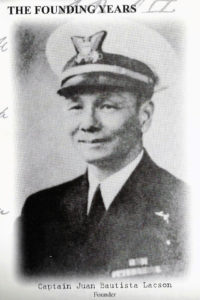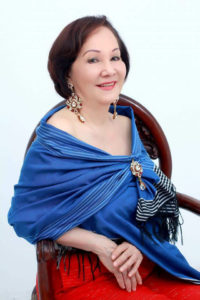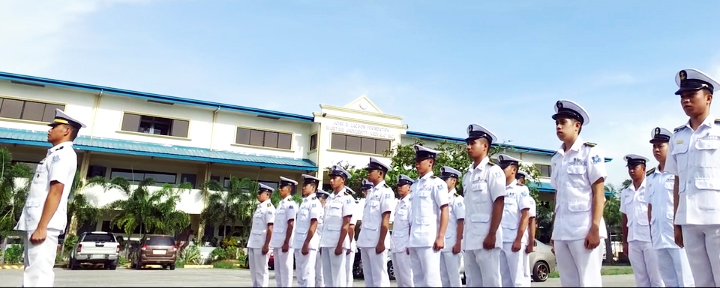Progress is evident in the city and province of Iloilo. The city teems with both private vehicles and public modes of transportation. The province is dotted with beautiful homes and commercial edifices. The place has become a destination for middle class leisure. This economy boost is attributed to the belief that in the city and province of Iloilo, there is at least one seafarer in every family. Seafaring has become a lucrative profession for the Ilonggo people, and being a contributor to the seafaring profession, is likewise a pride and joy of Iloilo City being the seat of the first maritime university in the country, the John B Lacson Foundation Maritime University (JBLFMU).
JBLFMU, the former Iloilo Maritime Academy, is the first maritime school in the Visayas and Mindanao regions; and the first private maritime education and training institution in the Philippines. The late Captain Juan Bautista Lacson, its founder, was a seafarer himself, who wanted to share his knowledge and professional experience.

History. The institution opened originally as a Review Center to assist seafarers in preparation for the licensure examinations for the Marine Deck and Engine Officers in May 1931. Seeing it prosper, Capt. Lacson further formalized the review classes to seafarers, giving birth to an unstructured organization of review classes for marine officers who wanted to upgrade their licenses to higher grades. The first class was composed of about 40 candidates; and 95% passed the examinations. When World War II broke out, the review school closed. Capt. Lacson went back to the US to serve as a U.S. Coast Guard Officer. When the war ended, Capt. Lacson perceived the potential of the marine profession being the fastest and the least expensive to join. He retired from the U.S. Coast Guard, went back to the Philippines and together with his brother, Frank Lacson, a pilot and a US government disability pensioner, drew a 2-year nautical curriculum. In 1948, 60 cadets had enrolled.
Enrollment increased year after year. In 1954, Capt. Lacson offered vocational courses for high school graduates. He then changed the name of the center to Lacson Vocational Institute. The curriculum included practical livelihood skills that could provide employment after high school graduation. It flourished until 1956 when the institute had to be abolished to give way to the marine engineering program that was badly needed by the maritime industry. Automotive mechanics and diesel mechanics were added to maximize the use of the equipment.
In 1957, Capt. Lacson decided to convert the institute to a stock corporation and registered it as the Iloilo Maritime Academy with the Securities and Exchange Commission. In 1958, Iloilo Maritime Academy was granted permit to conduct Naval ROTC training. In 1966, student activism gained ground in the campuses brought on by left-wing indoctrination. Despite the chaos and disquiet of the student leaders, Capt. Lacson bought a training ship for the use of the students, and was named M/B John B. Lacson. He had not wavered from his commitment to provide quality education and training to students. The training ship served as a floating laboratory, which gave the cadets some practical lessons by plying waters between Panay and Guimaras during the weekends.

Dr. Mary Lou Lacson Arcelo, President Emeritus & Chairman of the Board
The Daughter at the Helm. In 1968, activism grew out of hand. Labor strikes, demonstrations and pickets plagued almost every business establishment in the Philippines including the Iloilo Maritime Academy. Capt. Lacson was growing old and because of hearing problems, he found it difficult to deal with the multi-faceted problems of the school. He asked for assistance from his youngest daughter, Mary Lou Lacson, to help him with the labor problems and the increasing requirements of the Ministry of Labor. The academy’s labor union had been shaking the foundation of the administration. In 1972, Mary Lou came onboard as President, and conducted dialogues and meetings. Her leadership was able to bring back peace into the academy.
The entry of the young Mary Lou began the transformation of the Iloilo Maritime Academy into a more progressive institution. Her management style and accomplishments won the hearts of people under her command. New campuses were acquired and structures were constructed. New programs were introduced and methods and standards of instructions were improved. The institution applied for accreditations and recognitions in the national and international arena, and did not fail. Her promise to her father to give the management of IMA a 1-year try became a commitment for the long haul instead.
The Birth of a System. The expansion and growth of the school made it difficult for just one person to oversee and manage the different campuses. On 18-September-1993, during one of the regular monthly meetings, Dr. Mary Lou Lacson Arcelo recommended to the Board of Trustees to create and establish different units. This gave birth to the John B. Lacson Foundation System. Under its umbrella are the John B Lacson Colleges Foundation (JBLCF) Arevalo, which became the home of the deck cadets; JBLFC Molo, which offered the marine engineering program, customs administration, tourism, computer engineering, and cruise ship management; JBLCF Bacolod, which offered programs in nautical studies, marine engineering, customs administration, hotel and restaurant management; and Puerto del Mar, which became the seat for aquatic sports and the 13.6-hectare practicum site for SOLAS courses.
Each campus was designed to be autonomous under separate boards but bound by one common vision, mission, and set of objectives. All units were mandated to attain the same degree of compliance to the school’s criterion of excellence.
In 1991, the Norwegian Ambassador to the Philippines, H.E. Lars Tangeraas, became the first Norwegian to visit the institution. On his second visit, he took with him The Director General of the Norwegian Maritime Directorate, Ivar Sandvik and the Executive Director of the Norwegian Shipowners Association (NSA) Rolf Haselgard. Together, they paved the way for the Norwegian assistance to JBLFC. The first NIS Class started in June 1993. This opened greater opportunities for the youth in Region VI who aspire to become competent Merchant Marine Officers.
On 15-June-1992, Capt. Lacson bade his school goodbye, leaving a very influential and everlasting legacy: his name etched in every seafarer leaving the portals of the school as a Lacsonian. In 2006, the university became a recipient of the Philippine Quality Award. In 2007, the application for university hood was granted. The John B. Lacson Colleges Foundation became the first maritime university in the Philippines, as the John B Lacson Foundation Maritime University. With the change of name came an evolution of compliances in the courses offered.
JBLFMU Arevalo retained its offering of the Bachelor of Science in Marine Transportation and Graduate School Courses. With the implementation of the K-12 program, it added offerings for the Senior High School. The JBLFMU Molo also maintained its offerings of Bachelor of Science in Marine Engineering; Bachelor of Science in Customs Administration; Bachelor of Science in Business Administration; Bachelor of Science in Information Technology, Bachelor of Science in Cruise Ship Management; Bachelor of Science in Tourism; and Maritime Junior High School. Its latest addition is the Maritime Senior High School. The JBLCF Bacolod on the other hand still offered Bachelor of Science in Marine Transportation; Bachelor of Science in Marine Engineering; Bachelor of Science in Hotel and Restaurant Management; and now, the Maritime and Junior High School. The JBLF Training Center offers MARINA-accredited trainings for seafarers.
The JBLFMU is steered by its REAL culture —Resilience, Excellence, Agility, and Leadership— and is guided by its 7 core values: Integrity, Perseverance, Loyalty, Excellence, Discipline, Godliness, and Equality, or I-PLEDGE. In this quest, the institution is committed to its quality policy, which is “to comply with national and international standards and strive to exceed the customer’s expectations.”
All campuses are equipped with state-of-the-art training facilities used by students in their day-to-day learning activities. There is incorporation of the new technologies in the teaching and learning process such as eLearning and simulation (navigation, seamanship, radio communication-GMDSS). JBLFMU has opened its own maritime museum, which gives visitors a deeper understanding and appreciation of maritime history, maritime profession, and the Filipino heritage.
JBLFMU also undergoes voluntary and required accreditation and certification from the Bureau Veritas for its ISO, Philippine Association of Colleges and Universities Commission on Accreditation (PACUCOA), CHED, and TESDA.

Dr. Ronald Raymond Lacson Sebastian, CEO, JBLFMU
Capt. Lacson’s Grandson as CEO. In 2008, Dr. Mary Lou Arcelo’s youngest son, Dr. Ronald Raymond Lacson Sebastian, took over the reigns as Chief Executive Officer heading the Executive Council composed of the unit administrators, the auditors, the QA managers’ coordinators; and functions as the central and top management council of the institution. Dr. Mary Lou Lacson Arcelo remains as Chairman of the Board of Trustees, the top policy-governing body of the JBLF. The then Quality, Health, Safety and Environmental Protection policy, now the Integrated Management System policy, is one of Dr. Sebastian’s priority thrusts. This advocacy led the way for a strengthened community extension service, which includes the creation of the Guimaras Bike Paradise of the Philippines project, conceptualizing and pioneering of the Iloilo Bike Festival and spearheading the Paraw Regatta Festival both for Iloilo and Guimaras. Also a priority project for his leadership is the preservation of the Igang Bay Marine Sanctuary in Guimaras, which has now shown a remarkable improvement. JBLFMU has become a major supplier of Filipino marine officers, with a 12% contribution out of the 30% national contribution of the Philippines to the world’s seafaring manpower total. Before the K-12 program implementation, its linkages include 165 shipping companies, both international and domestic; a student population of 8,000, and a faculty force of 314, of which 123 are deck and engine officers. Amidst stiff competition with various other maritime institutions, the JBLF is one of the top 10 maritime institutions, having earned both global and national recognitions over the years. Its competitive advantage is highlighted by the many “firsts” that it has achieved, such as:
- The first maritime educational institution accredited by the Philippine Association of Colleges and Universities Commission on Accreditation (PACUCOA). (March 1986)
- The first maritime educational institution in the Philippines that has a Maritime High School. (1990)
- The first maritime school in the Philippines that has formulated and adopted the Enriched CHED Curriculum incorporating the IMO Model Courses. (June 1995)
- The first maritime educational institution granted Level III accredited status and re-accredited status, a distinction, which it holds up to this day. (October 1995)
- The first maritime educational institution in the Philippines to attain an international accreditation, the DNV Certification for its Quality Assurance System- the first in the Philippines, second in Asia and third in the world to have such a distinction. (November 1997)
- Among to the first cluster of 11 maritime educational institutions that have complied with the International Maritime Organization (IMO requirements, for the inclusion of the Philippines in the “White List”. Of the 11 schools, JBLCF was counted 3 times for its three campuses. (1998)
- The first maritime educational institution granted Autonomous Status. (October 2001)
- The first maritime institution whose graduate program was subjected to the PACUCOA preliminary visit for Level 1 accreditation. (2004)
- The first maritime institution to be a recipient of the Philippine Quality Award (PQA). (2006 and 2009)
- The first private maritime university in the Philippines. (2007)
- The first maritime school granted level IV accredited status by the PACUCOA. (November 2008)
- The first Philippine Maritime HEI to be a member of the International Association of Maritime Universities (IAMU) (2008)
- The first maritime school to be granted Institutional Accreditation Status by PACUCOA (2011)
- The first Philippine maritime school to be a member of the International Association of Maritime Universities (IAMU)
In relation to management undertakings, Dr. Mary Lou Lacson Arcelo was accorded the Juran Award in recognition of her achievements in promoting quality. She also became the 3rd Filipino to have been chosen as an Officer of the Royal Norwegian Order of Merit in recognition of her fruitful and mutually beneficial maritime cooperation with Norway.
Presently, Dr. Sebastian is steering the university towards coming at par with the challenges brought about by modernization and technology in maritime education. Under his leadership JBLFMU has established itself as The Maritime Vanguard, a leader and innovator in the field of maritime education and maritime-related courses. It has an Information Technology and Software Engineering Department that develops software programs for the university to make administrative procedures electronic and paperless. This department has also worked closely with a software developer to produce the JBLFMU App, launched in 2016, now available on Google Playstore. The app contains a rage of services to students, employees and stakeholders that are accessible through smartphones. The university also has an integrated Media Production, Public Relations and Corporate Communications Office that produces tri-media content for the institution.
Sustained by its flagship courses and the consistent adherence of its programs to international university standards, JBLFMU has contributed a positive impact to the maritime industry as a provider of excellent seafarers worldwide.
WELCOME ABOARD!
